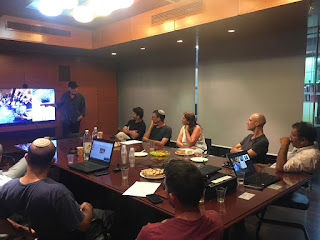 |
| Missiles fired from Gaza to Sderot |
In everything there is a lesson to be learned as the Israeli family from Sderot who recently moved to Poway, California discovered.
The elderly Isaac became blind because, as is warned against in the Gemara (Megila 28) he had too often gazed into the eyes of his evil son Esau. Isaac's good son Jacob on his return, after 20 years in exile was injured in his hip, lamed in a battle with the angel of his evil brother Esau, who bestowed on him the name Israel for prevailing over him.
The Gemara added that Avimelech, King of the Philistines cursed Isaac's mother Sara, when he found out that she was the wife, not the sister of Abram. Commentary about the curse centered on the word K'SooS[T], which normally means a garment, but suggested punctuation on the same letters could have rendered the word K'SiyaS[T], which would mean a cover - over your eyes. Its use in a curse would have meant to loose your eyesight, which is what had happened to Sara's son - Isaac. The Gemara accepts both reasons as valid.
After Avimelech's shepherds attacked Issac's wells, Isaac agreed with Avimelech to extend his father Abraham's peace-pact permitting all future decedents of the Philistine King to reside in the land of Isaac's inheritance. But, peace with the Kings antagonistic subjects was short lived, fragile at best. For his weakness in pursuit of improbable peace, Isaac was nick-named - "The Blind" and after Jacob returned to the home of his father the antagonists nick-named him "The Lame" because of his injured hip. Together they became known as The Lame and The Blind!
The coast in Aza, today known as Gaza, was once home to the Philistine antagonists. But, 10 Kilometers east, along the ridge of central hill territory their antagonist cousins occupied Isaac's inherited land spanning north from the Town of Four (Kiryat Arba) to Mount Moriah. Not long after Isaac's death, Jacob and his family of 70 escaped severe drought by immigrating to Egypt leaving behind the land he inherited, but had struggled to possess.
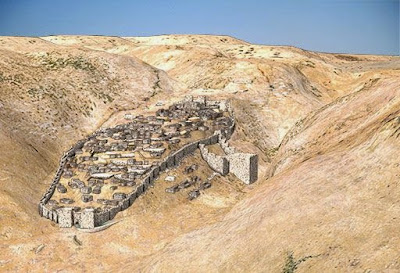 |
| Mount Moriah (looking north) - Jerusalem - time of Joshua |
For the entire 210 years of Israel's sojourn in Egypt the antagonists were free to spread their occupation and entrench themselves in the important cities of Kiryat Arba (which is Hebron) and Jerusalem on the lower southern slopes of Mount Moriah. Empowered, by their false beliefs narratives of The Lame and The Blind became entrenched in their antagonistic cultures as they mocked Israel.
Egypt provided a protected environment for the family of Israel to flourish. Jacob's son Joseph, who preceded their arrival had been empowered as the Egypts viceroy which provided the basis for the fledgling family of Israel to spread their influence. The family grew to millions, but toward the latter years, after Egypt's Pharaohs turned against them the path was established for their return to the land of their inheritance. Egypt's political alliances followed their direct family relationships to the Philistines along the Mediterranean coast and cousins to the inland mountain ridge, where news of Israel's rise against and threat of departure from Egypt spread.
The central hill antagonists anticipated Israel's return to their beloved Mount Moriah, the source of their inheritance:- The place, Noah's son Shem had practiced as the high priest of Salem, to whom Abraham had tithed his wealth, from whom Abraham descended:- The place Abraham had offered his son Isaac as a sacrifice :- The place Jacob had erected a standing stone, pillar or matzevah as a covenant to build the House of God. Intent on stopping their repossession, the antagonists lobbied their regional allies to provide labor and skilled stonemasons to erect a massive structure up the eastern slope of Mount Moriah and block
the sacred places that Israel would no doubt seek on their return.
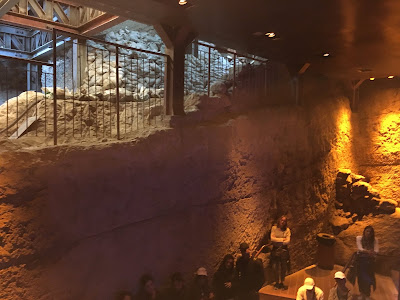 |
| Quarry - cutting access across eastern slope of Mount Moriah |
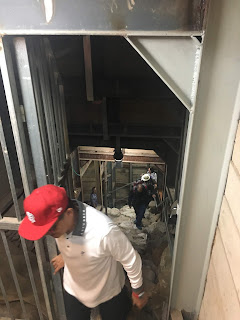 |
| To the sacred place on the eastern slope |
Quarrying massive stones from the adjacent rock plateau, they hacked Mount Moriah's lower, eastern mountain-side to ensure any prior access to the sacred places was forever impassable. One by one massive cut-boulders were lifted on top of each other progressively rising from valley floor up a steep slope to the most sacred place, 120 meters above the valley floor. The massive structure resembling a ziggurat, an ascending stepped structure and the quarry remnant would forever alter the landscape of the once naive, east facing slope of Mount Moriah.
The first of Israel's spies to return to this place could not believe what they saw. Their experience with the pyramids in Egypt must have led them to believe such similar structure on Mount Moriah was beyond human. It shook them to the core, shattered their confidence, motivated them to publicly express anxiety, report dangerous tidings and ultimately delayed Israel's return to their land by 40 years.
When Israel under Joshua finally entered the land of their inheritance and made their way to Mount Moriah, the antagonists were waiting on the very structure they had constructed in preparation. From their strategic vantage point they beat on drums, threw stones, displayed their idols and shouted reminders that Israel, the ascendants of The Lame and The Blind had an obligation and responsibility to honor their pact with the central hill antagonists and their Gaza kin. It took 300 more years before a brave King David (2 Samuel 5:8) finally antagonized the antagonists in a manner that induced their co-existence.
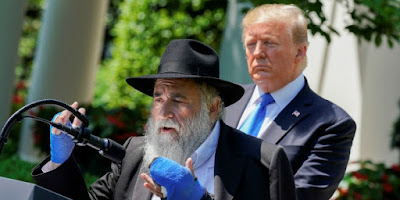 |
| Rabbi Goldstein on the White House Lawn |
Like those before them, today the antagonists of Gaza antagonize their neighboring Israeli residents with a constant barrage of missiles on places like Sderot. Israel cannot hide from antagonists, only their constant strong-arm, offensive, counter-antagonistic strategies will mimic the tactic of King David to neutralize the behavior of antagonists who otherwise will forever recall the curse of Avimelech. Israel must adopt the attitude of the Rabbi of Poway, who avenged the dead and injured to change the curse of terror to the blessing of peace!



